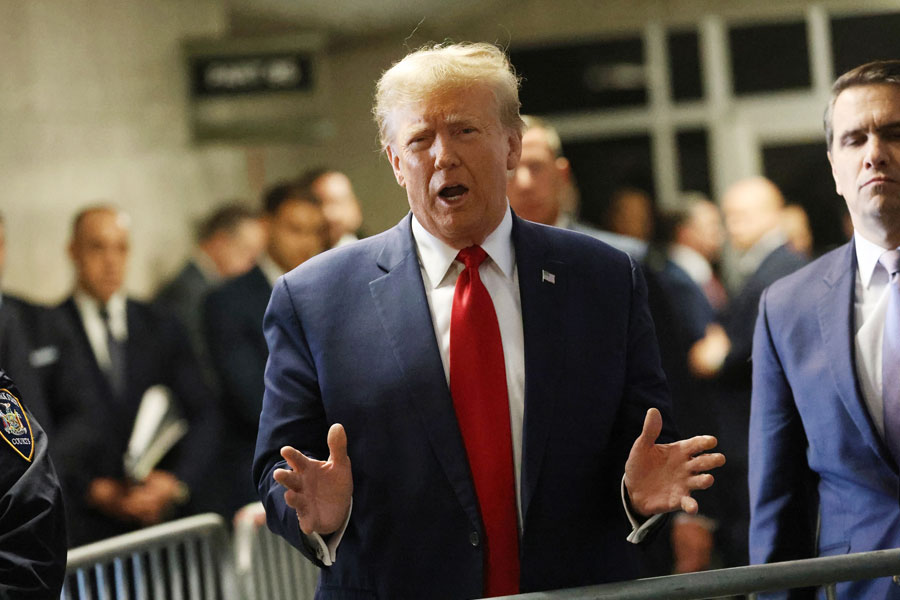President-elect Donald Trump has threatened to adopt a tit-for-tat approach against India’s high tariffs that have stymied US exports to one of the world’s largest consuming economies.
Trump told reporters at his Mar-a-Lago resort in Florida on Monday that his administration would hit back with high tariffs if India continued to slap high levies on American goods and services.
“If they tax us, we tax them the same amount,” Trump said while slamming India for levying duties as high as 100 per cent on some products.
Trump’s latest attack signals a confrontational stance towards India alongside countries like Brazil, Mexico and China that he criticised for their high tariff regimes.
“The word reciprocal is important…. India charges a lot. Brazil charges a lot. If they want to charge us, that’s fine, but we’re going to charge them the same thing,” he said, adding that he would bring fairness to the US trade regime.
India reacted with caution to the latest salvo from Trump.
“It is difficult to interpret Trump’s full intent from a few statements,” director-general of foreign trade Santosh Kumar Sarangi said at a Confederation of Indian Industry (CII) event.
“Reciprocal tariffs would clearly violate WTO norms. However, Trump has previously used measures like Section 232 of the US Tariff Act, which allows unilateral actions on national security grounds. We will have to wait and watch how this evolves.”
In a recent article, Douglas A. Rediker, a senior fellow at Brookings Institution, wrote: “Trump’s broader trade strategy reflects a worldview rooted in 19th-century mercantilism, emphasising protectionism and an aggressive use of tariffs,” Rediker wrote.
“Trump sees tariffs as multipurpose tools: sometimes as a means to an end — as negotiating leverage to cut a deal — and other times as ends unto themselves — both to encourage reshoring American manufacturing and to generate revenues to pay for tax cuts and spending,” Rediker added.
That is a strategy that has already put the US’s trading partners on edge.
Sarangi said India had tariff peaks in certain sectors, such as agriculture, but these do not heavily impact US imports.
“For example, India imposes high duties on agricultural goods, but we do not export many of these items to the US. If reciprocity is applied here, it might not harm us significantly,” he said. However, he cautioned that specific items could be affected if the US decides to embrace Trump’s strategy to use tariffs as a weapon against trading partners.
India’s trade relationship with the US is substantial, with the country being India’s largest trading partner in 2023-24. India’s exports to the US totalled $77.51 billion, while imports stood at $42.2 billion. Key Indian exports included pharmaceuticals, garments, diamonds, smartphones and solar cells.
Trump has criticised India’s tariffs in the past — and these have not been limited to import duties on motorcycles alone. In 2019, he referred to India as the “tariff king”, accusing it of imposing “tremendously high” duties on American products, including paper goods and Harley-Davidson bikes.
Ajay Srivastava, founder of the Global Trade Research Initiative (GTRI), said India’s average tariff rate of 17 per cent was significantly higher than the US average of 3.3 per cent, though comparable to nations like South Korea (13.4 per cent) and China (7.5 per cent).
“While Indian tariffs comply with WTO rules, any unilateral action by the US would violate its global trade commitments,” he said.
India has faced the wrath of the US in the past. In 2018, the US imposed tariffs on Indian steel and aluminium, citing national security. India responded by raising tariffs on 29 US products, ensuring a balanced trade response. “This demonstrates India’s capability to safeguard its trade interests while maintaining a measured approach,” Srivastava added.
He suggested India use the opportunity to reassess its tariff structure, particularly in areas that could boost low-cost manufacturing and exports.
“India must be prepared to respond decisively if Trump’s policies materialise,” Srivastava said. “A targeted reduction in tariffs could align with India’s economic goals while maintaining its global trade commitments.”

